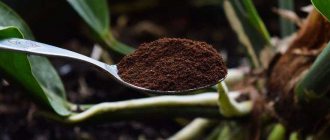For many of us, the morning begins with a cup of aromatic coffee. The dried grounds are often used as a scrub to cleanse the skin of the face and body. But there are other uses for coffee grounds. Experienced gardeners know that there is nothing better than natural fertilizers. Therefore, coffee grounds are successfully used as fertilizer. Is this method justified? Let's look at the pros and cons.
Benefits of coffee for plants
Ground coffee and boiled coffee grounds have been used for cosmetic purposes for many years. There are recipes for making face and body scrubs, tonic lotions, masks, and creams. But few people know that coffee can also be used in gardening.
Coffee beans are rich in microelements: Mg (magnesium), Ca (calcium), P (phosphorus), N (nitrogen), K (potassium). Phosphorus and potassium improve the ovary and yield of crops, and nitrogen takes an active part in photosynthesis, which will accelerate the development of the plant. Spent coffee will be useful not only for indoor and garden flowers, but also for garden crops.
Spent coffee can be used as fertilizer, regardless of the method of preparation.
The amount of useful substances is about 3% of the total volume. Therefore, coffee grounds cannot completely replace fertilizers, but they can be used as additional fertilizing.
Previously, I thought that coffee cake was only suitable for soil with an alkaline environment, since it has a fairly high level of acidity. But actually it is not. Research by scientists has shown that spent coffee has a neutral pH level. And the acid contained in whole grains is washed out when they are cooked.
From my own experience, I can note that coffee grounds help increase the yield of eggplants, carrots, radishes and tomatoes. Berries and fruit trees respond well to coffee fertilizing. Also, I noticed an increase in the number of buds and more luxuriant flowering of roses, lilies and begonias.
Another advantage of coffee fertilizing is its aromatic smell, which repels many pests, but, on the contrary, attracts earthworms, which contributes to better soil aeration.
Why you shouldn't use coffee
Unfortunately, despite its many benefits, coffee is not entirely perfect:
- Various studies have found that coffee grounds inhibit the growth and development of seedlings and seed germination.
- Coffee is blamed for the caffeine it contains, which has allelopathic properties in relation to seeds and seedlings. It should not be used for cuttings or growing seedlings. Sometimes coffee is bad for the growth of certain plant species (such as Tradescantia), so use it in moderation and observe how the plants react.
Reference. Allelopathy (Greek allelon - mutual and pathos - suffering) is the harmful effect of chemical substances secreted by plants or fungi of a given species or obtained as a result of the decomposition of these plants or fungi. Allelopathy is mainly due to chemicals released into the environment that affect the growth of other organisms, mainly plants and bacteria. Substances can inhibit the germination, growth and development of other plant species living in the immediate vicinity.
- There is no need to overuse coffee fertilizers for plants that like alkaline soil. These include:
- lavender;
- thyme;
- oregano;
- grape;
- Snapdragon;
- oleander;
- bougainvillea;
- Carolina yucca.
You should never go overboard with the grounds. Of course, it will not completely replace specialized fertilizers - it does not contain all the ingredients necessary for plants.
Coffee grounds can have many beneficial uses around the home. In an indoor pot or garden, it becomes an excellent fertilizer for flowers and other plants. Since it absorbs odors, it will also slightly freshen the air in the apartment. So let's not treat the grounds as waste - they will become valuable environmental fertilizers. It can be used as a long lasting organic fertilizer, mulch, compost, substrate or repellent.
What are the benefits of coffee grounds?
Coffee is more than just a dose of caffeine packed into a small cup. Most people, after drinking espresso or cappuccino, get rid of the grounds by throwing them in the trash. According to statistics, each person drinks 300-500 cups of coffee per year.
Assuming that we put a heaping teaspoon of coffee or 10 g into 1 cup, everyone throws out 3-5 kg of grounds annually. Before you throw away the grounds next time, you should think about how they can be reused in the garden, vegetable garden, or for plant nutrition.
Growing greens in coffee
You can experiment and grow greens at home, in cells or small pots containing coffee substrate. This method was proposed by the English industrial designer from London Blake Parkinson, which he called Urb. When growing in this way, it is very important to regularly fertilize the plants, otherwise they will lack micronutrients.
Effect of coffee residues on plants
Unlike other similar fertilizers, nitrogen taken from coffee is not absorbed as quickly by crops. For example, fertilizing tomatoes takes a certain time. The chemical element becomes active only after the decomposition of microorganisms and bacteria in the soil.
Those who hope for a positive result with natural fertilization of crops should remember that its slow activation can play a negative role, because gardeners think not only about nitrogen, but also about phosphorus and potassium. Squeeze is rich in these elements in approximate proportions:
Coffee contains magnesium and copper, and calcium, zinc, manganese and iron become available after decomposition.
Many people believe that using coffee grounds in the garden leads to increased soil acidity, but almost all chemical compounds dissolve during brewing. Subsequently, a neutral acid-base balance is created, and the soil becomes a favorable environment for vegetables.
Types of fertilizers for crops
There are two types of fertilizers
- organic;
- mineral.
Mineral fertilizers are synthetic fertilizers created by the chemical industry.
There are such feedings
- complex, containing nitrogen, phosphorus, potassium;
- single-component, for example, nitrogen.
Organic are supplements that are obtained naturally. This can be bird and animal manure, compost, wood ash. There are supporters of both types of fertilizers. The best results come from a reasonable combination of organic and mineral fertilizers.
Cake for the garden
The role of coffee grounds as fertilizer in aerating the fertile layer and protecting against slugs is irreplaceable. The powder composition attracts earthworms, but is undesirable for slugs and snails. Also, red ants and rabbits do not like coffee: they leave the area.
To repel ants from the area, you need to sprinkle dry powder on the paths or sprinkle coffee substrate on the anthill. To repel aphids and slugs, plants are sprayed with a liquid solution.
If you need to protect your garden beds from cats, sprinkle them with a mixture of coffee grounds and orange zest.
Tomato seedlings respond well to coffee fertilizer. For tomatoes, the cake is used throughout the growing season. Thanks to the attraction of beneficial soil microorganisms and the formation of bacterial strains, the fertile layer is enriched with essential nutrients.
For berry bushes, cake is used as follows. You need to scatter 2-3 cups of dry substrate around the roots and water them with water. And when planting a young seedling, place three to four cups of dry fertilizer in the hole and water it. The cake is pre-mixed with the soil.
Note! An important property of dormant coffee is the delay in the accumulation of nitrates in vegetable fruits.
Mulching with thickets protects garden flowers and fruit trees from slugs and other parasites without the use of chemicals. Caffeine acts as a poison on pests and destroys their population. Also, the smell of coffee repels insects and other unwanted “guests” in the garden. However, it is recommended to mix the cake with soil so that it does not form a dense film around the trunk, preventing air permeability.
How to feed flowers
If you grow roses in the garden, then coffee fertilizer will be very useful for roses. Dry waste should be mixed with chopped grass and sprinkled on the flowerbed. You can add it to the water you use to water your roses. With this fertilizer, the rose bushes will be covered with new buds.
For rose bushes, the grounds can be added to the top layer of soil. It will make it loose and light, which will facilitate the flow of oxygen to the roots.
Rose bushes that receive magnesium, phosphorus and nitrogen will slightly change the color of the buds. This phenomenon is interesting to observe. If you do not want the color of the roses to change, then it is better not to water them with a solution containing grounds.
To make tulips, peonies, lilies, and hostas bloom longer, you can also use ground brewed coffee.
Coffee grounds are not only a top dressing for these flowers, but also a way to enhance the color of the foliage and improve the decorative appearance of the buds.
When to feed garden flowers: the first time in early April, when the first shoots appear, and then every 2-3 weeks. This feeding is useful not only for plant growth, but also for repelling snails that like to feast on flower bulbs.
Feeding indoor plants with dormant waste will also give good results. When to apply cake to indoor plants:
- When transplanting into another pot. Mix dry waste with soil, put it in a pot, then plant the plants.
- When you first plant a new plant.
- Once a month you can fertilize with dried grounds to eliminate the possibility of midges. You should also wait until the top layer of soil dries after the last watering.
- To prevent the flowers from changing the color of the foliage and buds, you should water them with the same water in which the coffee residues were infused.
Preparing the Coffee Grounds
To prepare the fertilizer, you must use only used, that is, boiled coffee. Ground but not boiled grains have too high acidity, which can change the overall pH level of the soil, negatively affect the development of crops, and even lead to their death. For the same reason, I do not recommend pouring leftover liquid coffee under the plants.
The coffee grounds must first be dried. To do this, spread it in a thin layer on parchment paper, you can use an old sheet or towel, and leave it for a couple of days.
Only well-dried coffee can be used as fertilizer.
You can also use the oven to dry it, this will speed up the drying time, but you need to be careful not to overcook the coffee grounds. Raw or poorly dried coffee can quickly become infected with fungus, which can cause disease in the plants.
It is advisable to store coffee grounds after drying in a tightly closed container to avoid moisture and prevent the aroma from fading.
Use in everyday life
Housewives successfully use coffee grounds:
- As a refrigerator deodorizer.
- Rubbing your hands with it after preparing food with garlic will get rid of unpleasant odors.
- It is widely used in the fight against fleas in pets. All you need to do after bathing your pet is rub it into the fur.
- By adding it to a vase with decorative flowers, it will play the role of an air freshener.
- Widely used in cosmetology for the preparation of anti-cellulite creams, peelings, and masks for puffiness under the eyes.
- It can be used as a dishwashing detergent; it is ideal for cleaning any frying pan or pot from dirt.
- It is widely used for hair care, making various hair masks that not only strengthen, but also promote hair growth.
- Housewives use it as a dye for eggs, paper and even some types of fabrics.
From all of the above we can conclude: coffee is not only an invigorating drink, but also an indispensable tool in everyday life. And coffee grounds for plants, gardens and vegetable gardens are the best natural fertilizer.
How to use grounds in the garden
It can be mixed with plant seeds (carrots, beets), this will speed up germination. A mixture of soil and dry coffee substrate is placed in planting pots for seedlings; this soil mixture gives excellent results. The seedlings grow strong and can easily be transplanted into holes.
You can also scatter the substance around the rooted seedling, which will facilitate an increase in nitrogenous substances in the fertile soil layer after each watering.
Note! If you set fire to a handful of cake in the house, all the flies and mosquitoes will fly away.
Fertilizer can be buried to a depth of about 4 mm. This method will retain moisture after watering and provide an influx of oxygen into the soil.
When planting, use compost with grounds mixed with the fertile layer in half. This will provide the seedlings with the necessary nutrition.
Also, dry grounds are simply diluted with water and irrigated green spaces.
Improving the mechanical properties of soil
Spent coffee is used as a fertilizer in the country to improve the mechanical characteristics of the soil. The soil texture is improved by the biological elements of the grounds. It is especially useful to use cake on soils of heavy texture - clayey, loamy. On sandstones, coffee cake reduces acidity, which has a beneficial effect on the composition of the fertile layer.
Note! Coffee protects the garden from weeds.
However, if you regularly use cake for mulching, the soil layer can become compacted and begin to impede air permeability. Therefore, mix the substrate with fertilizers of a larger fraction.
How to use grounds to improve soil and control pests
Spent coffee grounds are widely used in the country: in the garden, vegetable garden and greenhouse. Experienced gardeners use it:
1. For mulching plantings.
2. For light acidification of the soil.
3. To improve the mail structure. Adding dried coffee to the soil mixture makes it more airy and lighter. At the same time, it is important not to pile coffee grounds in a thick layer around the plants, otherwise they can cause the appearance of a dense soil crust that prevents free access of air and moisture to the root system of the plants.
4. In addition, coffee grounds can be used to make compost, which can later be used to grow flowers, vegetable seedlings and mushrooms. To prepare it, you need to put the following in a compost pit specially designated for this purpose:
Attention! If desired, you can also add some leaves, pine needles, bone meal, and even cardboard or paper to the mixture.
All components must be mixed well, sprinkled with soil and water on top, and then use a stick to make several holes in the pile. Useful compost will be ready for use in just 4-6 weeks. During this period, you should ensure that the pile is always wet.
5. To get rid of ants and snails. Ants cannot stand the coffee aroma and will disappear from the greenhouse if you sprinkle coffee on their nests. The same applies to snails - they will stop annoying plants if you sprinkle coffee grounds on the soil around them.
6. To wean your cat from digging holes in the garden, you should use a mixture of crushed orange peels and drunk coffee. By scattering the fragrant mixture around the plants, you can be sure that the cat will not make a toilet in the beds.
Methods of use
Watering
Before using used coffee as fertilizer when watering plants, it must be diluted in a sufficient amount of liquid. To prepare a solution for 10 liters of water, 1 cup of grounds is required. The cake is poured with a small amount of water and left to swell for about a day. After swelling, the amount of liquid is adjusted to the calculated value and used for watering plants.
After feeding the plants with coffee grounds, it is advisable to water the soil again, but with clean water. This technique will allow the minerals to be slowly released to nourish the plants. When planting bushes, you should spill the soil with coffee solution at the rate of 1 liter per bush.
Mulching
Coffee grounds can also be used to mulch plantings to protect the soil from drying out, repel pests and improve the structure of the soil. However, it must be remembered that when using grounds as mulch, as in the case of using coffee cake as fertilizer in a garden at the dacha, you should dry it thoroughly to prevent the development of mold.
Soil Supplement
Dried ground coffee as a fertilizer can be added to the planting hole or hole before planting to improve the soil structure. This technique makes the soil more drained and loose, which ultimately has a positive effect on the health of the plants and the volume of the harvest. When used on light soils, the grounds act as a binding component. In this case, fertilizing is applied to the top soil layer at the rate of 200 ml per 1 m².
Compost
To speed up the ripening of compost, it is enough to pour coffee infusion on each layer no more than 10 cm thick. Coffee grounds act as nitrogen components that trigger an exothermic reaction inside the compost heap, in other words, heating it up, which makes the compost ripen much faster. This method is so effective that some summer residents specifically purchase inexpensive varieties of ground coffee and sprinkle layers of compost over them.
For seedlings
Recently, the method of growing vegetable seedlings on a coffee substrate has become popular. But in order to prevent soil depletion, it is necessary to feed the seedlings with complex fertilizers from time to time.
Pest protection
Coffee cake as a fertilizer in the garden is also very effective for protecting plants from mature individuals of harmful insects - ants, snails, aphids, slugs. According to the experience of some gardeners, coffee can also destroy pest larvae, in particular mosquitoes and garden bugs. This product is not as effective as insecticides, but it is also much safer.
Nutritional value of coffee for plants
The amount of nutritional components in coffee grounds depends primarily on the preparation method. During vacuum cooking, most proteins, amino acids, potassium, and magnesium enter the water. With the Turkish method of preparing coffee, more nutritional components remain.
It is believed that caffeine inhibits the growth of crops, but after heat treatment there is little of it left in the cake, so coffee is used safely as a fertilizer for indoor plants.
Coffee is also used fresh. True, ground it contains a lot of active nitrogen, which, when decomposed, releases ammonia and can harm the root system.
Because of its ability to increase the acidity of the soil, ground coffee benefits plants that prefer low soil pH - rhododendrons, heathers, azaleas, hydrangeas.
After digestion, the pH level decreases several times, so there is no danger to plants. It is better to first soak ground coffee as a flower fertilizer in water, then spray or water it at the root.
How to properly prepare coffee grounds
There are tips on the Internet to negotiate with the owner of the coffee machine or coffee shop and buy (or take away for free) the coffee cake from him.
This is, of course, a good idea. Only all spent coffee received for free will have to be re-rinsed under the tap or in another way. The fact is that, in addition to sugar, it may contain much less harmless additives - milk, artificial flavors, and so on.
It is also important to remember that only used ground coffee is suitable for preparation. Fresh grains or instant drink are not suitable due to their high acid content and unnaturalness.
This is how I collect coffee grounds:
- After the coffee break, I pour the remaining drink into a strainer, squeeze out the water and place it on the radiator to dry;
- After a day, I pour the dry product into a glass jar.
- I store the fertilizer in a cool, dark place under a lid.
Coffee grounds - benefits for vegetables
Due to its high potassium content, coffee cake is used for growing tomatoes, cucumbers, potatoes and other vegetable crops. If it is possible to get a lot of coffee residues somewhere, and these are cafes, restaurants, private stores, then you can make fertilizing for fruit trees. Fruiting next year will be better.
Flowering ornamental plants that need potassium, starting from the budding period, also respond to the introduction of coffee cake - used as mulch or by watering.
Coffee grounds are used not only for fertilizer. It attracts earthworms to the site, which help improve soil aeration, and also release coprolites rich in humic acids into the soil.
How to use coffee grounds to control insects
Coffee not only increases the acidity of the soil, it serves as a deterrent to pests. The cake repels snails, slugs and other inhabitants that interfere with the normal growth of garden and indoor plants. For prevention, it is scattered over the flower garden and vegetables. Spent coffee is mixed with orange peel and rosemary oil. Such scents do not attract cats or dogs.
Instant coffee against slugs
Dilute 2 tsp in a glass. coffee with hot water (a little cognac can be added there) or whiskey, cool and pour into a sprayer. Treat the cabbage with the prepared liquid. The worms die, but to prevent them from multiplying, you need to water the vegetables at least once a week. Inexpensive, finely ground coffee may be suitable for such purposes.
Some gardeners show curious ingenuity. Before scattering the seeds, coffee cake is mixed with them, and thanks to a little trick, carrots and radishes germinate faster than usual. For cultivation, gardeners use only pure extraction without additives:
Before use, summer residents advise rinsing the grounds to get rid of unnecessary fillers.
During the summer, summer residents put all organic residues in a compost heap or use them as fertilizer. In winter, as a rule, all food waste and coffee waste from the coffee machine go into the trash. But in the spring you can arm yourself with organic matter if you collect it.
Coffee delicacy for seedlings of tomatoes and peppers
Young shoots of garden crops become stronger and bear fruit better in the future when they are fed with organic waste. Just like coffee lovers, some plants need this treat.
Other uses of coffee in the garden
In addition to the fact that gardeners and lovers of window flower gardens use coffee grounds to supply plants with valuable substances that give them a healthy appearance, intense color and stimulate lush and long flowering, they have also found other uses for the garden.
Coffee from pests in the garden
Not all insects on the site are useful and desirable. Spent cake will help get rid of various pests without harming plants or using chemicals. The smell will repel midges and flies that love vegetables, especially carrots and onions. The presence of coffee grounds in the ground will save the plants from slugs and ants, which often appear in the garden and spoil the future harvest.
Soil improver
If the soil is poor in magnesium, copper, phosphorus, and nitrogen, then coffee grounds will enrich its mineral composition. Of course, a large plot will require a lot of fertilizer. If we are not talking about indoor plants, but about a full-fledged garden or vegetable garden, then you will have to collect the cake from autumn to spring, drying the portions so that mold does not form.
The worms, attracted by it, like coffee; they actively process the soil, making it looser and airier, which makes it easier for oxygen to reach the roots of plants.
Coffee grounds compost
To prepare it, you will need straw, fallen leaves from trees or grass torn out when cultivating the site and at the end we add coffee residues to the compost. You can also send shells from raw eggs, trimmings of raw fruits and vegetables, paper, husks from seeds and nuts, rags from natural fabrics, sawdust, thin branches, and feathers. Any organic waste will do. All this is placed in a compost pit on a drainage mat of branches, layers of organic matter alternate with soil. From time to time the mass needs to be stirred to enrich it with oxygen and to accelerate the decay process. The finished compost from coffee grounds is loose, dark and smells like forest soil.
Coffee grounds mulch
You can often find the word “mulching” on websites or in literature devoted to plant care. It denotes an autumn procedure that is carried out after the entire harvest has been harvested and the owners begin to prepare the land for rest. The soil is covered with something in order to protect it from being blown away by winds and freezing in winter.
If such an action is carried out in the summer, then the level of moisture in the soil is better maintained and the growth of weeds is reduced. Mulch can consist of grass, bark, sawdust, hay. Mulch made from coffee grounds has proven itself to be excellent.
Cat repeller
Gardeners are often annoyed by cats that wander around all the yards and gardens. It seems that they do little harm, but few people like the smell of cat urine, feces buried in the garden, or races and animals fighting in the garden beds with young shoots or seedlings. Coffee grounds scattered around the garden will reliably scare away these uninvited guests with their smell. In addition to the aroma of coffee, cats do not like citrus scent and vinegar.
Coffee is an amazing product. Each cup of drink contains a celebration of taste and vigor. Even its remains are used in various fields and bring maximum benefit. Gardeners and gardeners have found their use for coffee grounds in improving the soil of the site and increasing productivity, pest control and other pressing issues for every person working on their land.
Coffee as fertilizer
Most often, gardeners and gardeners use coffee as a fertilizer. It has been proven that coffee is very rich in magnesium. Therefore, first of all, they are recommended to feed those plants that are deficient in this microelement. But how do you understand that a crop needs magnesium? Very simple - by leaves.
With magnesium deficiency, the interveinal areas of the leaf plate turn reddish-brown (sometimes dark yellow), while the veins themselves do not change color and remain green. Only the old (lower) leaves are affected; the young leaves remain green. Sometimes, with a lack of magnesium, the edge of the sheet becomes deformed (curled) or brown spots appear along the edge of the plate.
In addition, it is believed that coffee is rich in nitrogen, an element that is especially necessary for young, recently planted crops, since it is nitrogen that helps grow thick green mass.
You can also determine the lack of nitrogen by looking at the leaf. If this element is not enough, the lower leaves of the plant turn yellow, and first the veins turn yellow, and then the interveinal areas. The plant looks lethargic, develops slowly: no new shoots, small leaves, few inflorescences.
If all signs of magnesium or nitrogen starvation are present on the plant, you can try feeding it with coffee.
The dried coffee grounds should be mixed with soil or simply poured into the bottom of the hole, and then the plant should be planted. If the crop has already been planted, the coffee should be lightly buried in the top layer of soil and watered generously.
Coffee as a remedy for aphids, ants, slugs and other pests
Many gardeners have noticed that sleeping coffee helps fight certain insect pests. Especially ants, slugs and aphids. Of course, it is unlikely to replace full-fledged industrial insecticides, but it is quite capable of coping where there are few parasites and it is important to maintain the ecological cleanliness of the area.
Using coffee against insects is very simple - you need to dry the grounds thoroughly and then sprinkle them thickly on the pest-infested soil. The pungent aroma will repel insects from flower beds and beds.
If pests attack the plant itself (such as aphids), you should prepare a coffee infusion: pour 5-6 tablespoons of dried coffee cake into a liter of hot water, cool, and let it brew for a day. For better adhesion, add 10 g of laundry soap. Pour the resulting solution into a spray bottle and then spray it over the leaves and stems.
[!] Coffee can not only repel pests, but also attract useful garden helpers - earthworms. They like the pleasant smell of ground beans, so the worms willingly settle in soil mixed with spent coffee grounds.
Coffee for indoor flowers
It would seem like a great idea to brew a cup of coffee and pour the rest into a pot with a houseplant. It’s good for the plant, and there’s no need to throw anything away. Actually, it's a bad idea. Experienced flower growers are categorically against coffee grounds on the surface of the soil of home flowers.
[!] The fact is that dormant coffee, used in this way, is an excellent breeding ground for a wide variety of parasites: from fungus gnats and fungus gnats to mold fungi. Of course, in such conditions the plant will get sick and may even die.
Of course, you can feed sleeping coffee to green pets growing in the room, but this should be done wisely. Do not pour the grounds on top of the ground, but mix them with the soil when replanting the plant. The recommended proportion is 1 part grounds to 10 parts soil. This way the coffee will be evenly distributed in the pot and will gradually release nutrients to the roots.
Another technique for using coffee for home plants is as follows: when transferring, arrange a bottom layer of expanded clay, and then cover it with coffee grounds 1.5-2 cm deep. In this case, coffee will serve not only as fertilizing, but also as additional drainage.
*** One of the popular British botanists conducted an experiment: he watered the plants with fresh coffee. Based on the results of the experiment, the Briton found that the crops receiving coffee began to get sick and lag behind in development, and concluded that coffee is very harmful to plants.
In fact, the botanist made several mistakes. First, I used a fresh drink that acidifies the soil. And secondly, he brought coffee only to the surface of the earth, without deepening it or mixing it.
This, of course, cannot be done, and in this case the coffee will really be dangerous for the plants. But if you use coffee grounds correctly, this additive will not harm at all, but will only improve the health of our green pets.











